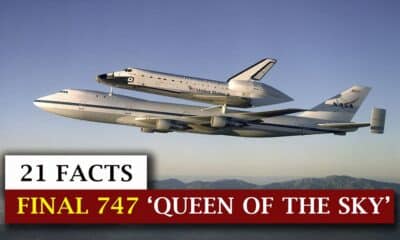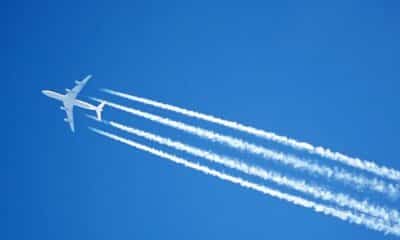Aerospace
Why is aircraft maintenance so expensive? Here are the details

Aircraft maintenance is an essential process that ensures the safety and airworthiness of an aircraft. The cost of aircraft maintenance can be quite high due to several reasons:
- Specialized Equipment and Skilled Labor: Aircraft maintenance requires specialized equipment and skilled labor, such as certified mechanics, engineers, and technicians, who have undergone extensive training and certification processes. These professionals work with precision and accuracy, using expensive tools and equipment to carry out maintenance and repair tasks.
- Extensive Inspection Requirements: Aircraft have extensive inspection requirements that need to be carried out at regular intervals to ensure their safety and compliance with regulations. These inspections involve the use of specialized equipment such as borescopes, which are used to inspect the interior of the engine, and other testing equipment that needs to be maintained, calibrated, and replaced when necessary.
- High-Quality Parts and Materials: The quality of parts and materials used in aircraft maintenance is crucial for ensuring the safety and airworthiness of the aircraft. The parts and materials used need to meet strict standards and regulations, which often come with a higher price tag than standard commercial parts.
- Compliance with Regulations: Aircraft maintenance is highly regulated by aviation authorities such as the Federal Aviation Administration (FAA) and the European Aviation Safety Agency (EASA). These regulations impose strict standards and requirements for maintenance and repair, which can lead to additional costs to ensure compliance.
- Research & Development: The component of the airplane was designed after extensive research and rigorous testing under challenging conditions under various climatic conditions. These parts are pricey for that reason.
- Downtime Costs: Aircraft maintenance can cause aircraft downtime, which can lead to lost revenue for airlines and operators. As a result, maintenance tasks are often scheduled during off-peak periods, which can cause additional logistical and scheduling challenges.
- Maintenance schedules: Companies develop a poor maintenance reputation through their maintenance schedules. Several “suggested” schedules must be followed, though the operator occasionally rescinds them. Instead of changing the parts as they reach their manufacturer’s limit, they are essentially pushing them to the point of breakdown. Unscheduled maintenance takes longer to fix, which results in significant losses for the airplane operator.
- Airworthy: For parts to be regarded as airworthy, at least in civilian markets, they must be certified. Experimental flyers don’t have as much money or fly for profit, despite the fact that this expense is genuine, so a manufacturer may raise the price greatly as a kind of price discrimination.
- Expensive components: It is possible to swap out expensive components for more affordable ones, but doing so may require the pilot to interact with the new components, incurring additional training and familiarisation costs. This is preferable to just asking the pilot to figure it out on the fly.
- Accountability: The major cost is accountability. A certified technician is required to sign off in the maintenance log each time they approach or touch an aircraft for maintenance. The risk that an airplane maintenance shop is exposed to is astonishing. The insurance premiums that an airplane mechanic pays are nowhere approaching those of a brain surgeon or a heart surgeon. Indeed, his store does. And the mechanic at the Ford dealership makes more money than the technician who works on airplanes. You will pay a LOT of money to engage an experienced shop to look into the aircraft maintenance logs if your business is considering purchasing or leasing a multi-million dollar aircraft.
All these factors contribute to the high cost of aircraft maintenance, but they are necessary to ensure the safety and airworthiness of the aircraft, which is critical for the aviation industry.

Aerospace
Indigo will soon launch Air Taxi Service in India

InterGlobe Enterprises, the parent brand of IndiGo, is set to revolutionize travel in India with its upcoming air taxi service.
Scheduled for a potential launch in 2026, this innovative venture promises a seamless journey for passengers between two bustling hubs. Delhi and Gurgaon in Haryana. The forthcoming service is projected to revolutionize the daily commute, offering passengers a swift aerial journey covering the distance in a mere 7 minutes.
This remarkable efficiency contrasts starkly with the conventional 90-minute drive, underscoring the immense time-saving potential for commuters. The anticipated fare, ranging from Rs 2,000-3,000, makes this innovative mode of transport not only swift but also remarkably competitive in pricing.
At the heart of this ambitious endeavor lies a strategic partnership with Archer Aviation, a pioneer in electric vertical takeoff and landing (eVTOL) aircraft technology. Under this collaboration, Archer will supply 200 state-of-the-art eVTOL aircraft, representing an investment of US$ 1 billion. These cutting-edge aircraft, capable of accommodating up to four passengers alongside the pilot, epitomize the future of sustainable air travel.
Powered by six battery packs, Archer’s eVTOL aircraft boast rapid charging capabilities, enabling a swift turnaround between flights. With a charging time of just 30-40 minutes, these eco-friendly aircraft ensure minimal downtime, maximizing operational efficiency.
Similar services are anticipated to be introduced by the joint venture in Bengaluru and Mumbai as well. Nevertheless, the service rollout period has not yet been made public by the company. Next year, it is anticipated to get its certification. Following this, the company will start the certification procedure with the Directorate General of Civil Aviation (DGCA).
Aerospace
Which is bigger 777x or 787 aircraft ?

The 777X is a new series of the Boeing 777 family and is designed to be larger and more efficient than its predecessor. It features two variants: the 777-8 and the 777-9, being the larger of the two.
The Boeing 777X emerges as the larger sibling within the Boeing family, representing a significant leap forward in both size and efficiency. Comprising two variants, the 777-8 and the 777-9, the latter takes the crown as the larger of the two. With its expansive fuselage and impressive wingspan, the 777X is tailored for long-range journeys and boasts a substantial passenger capacity.
On the other hand, the Boeing 787, affectionately known as the Dreamliner, occupies a niche in the market as a smaller yet formidable aircraft designed for medium to long-range flights. Its distinguishing feature lies in its composite fuselage, a technological marvel that renders it lighter and more fuel-efficient compared to conventional aluminum counterparts. The Boeing 777X is larger than the Boeing 787 aircraft.
When it comes to passenger capacity, the 777-9 reigns supreme, typically accommodating a sizeable contingent of 400-425 passengers in its standard configuration. In contrast, the 787, with its more modest dimensions, typically carries between 240-290 passengers, depending on the variant and layout.
One of the remarkable innovations introduced with the 777X is its folding wingtips, a feature designed to address the logistical challenges of accommodating such a large aircraft in conventional airport gates. These folding wingtips enable the 777X to retract its wings, allowing it to fit into gates designed for smaller aircraft while still reaping the benefits of an extended wingspan during flight, thereby enhancing fuel efficiency and operational flexibility
Aerospace
China Secures Production Certificate for Mass Production of Pilotless eVTOL Aircraft

The first passenger-carrying pilotless electric vertical takeoff and landing (eVTOL) aircraft in the world, the EH216-S, has received the Production Certificate for its eVTOL aircraft from the Civil Aviation Administration of China (CAAC).
This is a significant milestone for EHang Holdings Limited, the leading UAM technology platform company in the world. This outstanding accomplishment is another big step towards mass manufacturing for the eVTOL aircraft and the ensuing commercial operations, building on the ground-breaking acquisition of the Type Certificate and the Standard Airworthiness Certificate for the EH216-S.
The PC is a crucial certificate that the aircraft maker receives from the CAAC, the country’s aviation authority. By obtaining this certificate, EHang has demonstrated that it has set up a quality management system for mass production that satisfies the airworthiness regulation standards set forth by the CAAC, and the company has been given permission to continue producing mass quantities.
It is also a strong guarantee of the calibre of the goods made by EHang. Raw materials, supplier management, manufacturing organisation, production quality control, aircraft pre-delivery test, after-sales repair and maintenance, etc. are all included in the mass production quality management system for the EH216-S.
To ensure that every aircraft and its components that roll off the production line strictly adhere to the approved type design and safety requirements, the system sets clear guidelines and documentation for every step in the production procedure. This ensures comprehensive traceability and safety control.




























